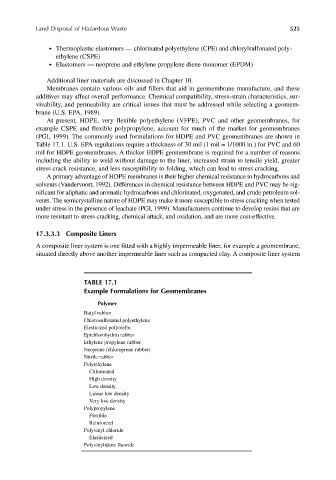Page 554 - Materials Chemistry, Second Edition
P. 554
CAT3525_C17.qxd 1/27/2005 12:44 PM Page 525
Land Disposal of Hazardous Waste 525
● Thermoplastic elastomers — chlorinated polyethylene (CPE) and chlorylsulfonated poly-
ethylene (CSPE)
● Elastomers — neoprene and ethylene propylene diene monomer (EPDM)
Additional liner materials are discussed in Chapter 10.
Membranes contain various oils and fillers that aid in geomembrane manufacture, and these
additives may affect overall performance. Chemical compatibility, stress-strain characteristics, sur-
vivability, and permeability are critical issues that must be addressed while selecting a geomem-
brane (U.S. EPA, 1989).
At present, HDPE, very flexible polyethylene (VFPE), PVC and other geomembranes, for
example CSPE and flexible polypropylene, account for much of the market for geomembranes
(PGI, 1999). The commonly used formulations for HDPE and PVC geomembranes are shown in
Table 17.1. U.S. EPA regulations require a thickness of 30 mil (1 mil = 1/1000 in.) for PVC and 60
mil for HDPE geomembranes. A thicker HDPE geomembrane is required for a number of reasons
including the ability to weld without damage to the liner, increased strain to tensile yield, greater
stress crack resistance, and less susceptibility to folding, which can lead to stress cracking.
A primary advantage of HDPE membranes is their higher chemical resistance to hydrocarbons and
solvents (Vandervoort, 1992). Differences in chemical resistance between HDPE and PVC may be sig-
nificant for aliphatic and aromatic hydrocarbons and chlorinated, oxygenated, and crude petroleum sol-
vents. The semicrystalline nature of HDPE may make it more susceptible to stress cracking when tested
under stress in the presence of leachate (PGI, 1999). Manufacturers continue to develop resins that are
more resistant to stress cracking, chemical attack, and oxidation, and are more cost-effective.
17.3.3.3 Composite Liners
A composite liner system is one fitted with a highly impermeable liner, for example a geomembrane,
situated directly above another impermeable liner such as compacted clay. A composite liner system
TABLE 17.1
Example Formulations for Geomembranes
Polymer
Butyl rubber
Chlorosulfonated polyethylene
Elesticized polyolefin
Epichlorohydrin rubber
Ethylene propylene rubber
Neoprene (chloroprene rubber)
Nitrile rubber
Polyethylene
Chlorinated
High density
Low density
Linear low density
Very low density
Polypropylene
Flexible
Reinforced
Polyvinyl chloride
Elasticized
Polyvinylidene fluoride

